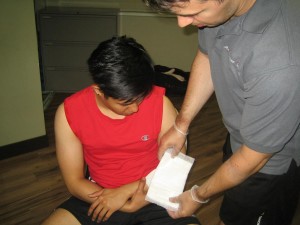A skin flap is a healthy skin that is partly disconnected and moved to cover a nearby wound. The skin flap has skin, fat and muscle. Usually, a skin flap is still attached to the skin and underlying blood vessel. A skin flap can also include muscle and cartilage.
Skin flaps can be unpleasant and painful. Depending on the seriousness of the injury, there is a need to treat the wound immediately.
Treatment for a skin flap
- The hands should be cleaned properly before touching the skin flap to prevent infection. Wash hands using soap and water properly before attending to the wound. If possible, wear sterile latex gloves.
- Stop the bleeding by pressing a sterile gauze pad or pad firmly over the wound. If the gauze is soaking with blood, apply another cloth over the first until bleeding is minimized.

Stop the bleeding by pressing a sterile gauze pad or pad firmly over the wound. - Telfa dressings or nonstick gauze that does not stick to surface of the wound can be used. If the wound is on the arm, elevate the area while applying pressure until the bleeding subsides.
- When bleeding subsides, clean the wound thoroughly to reduce the risk for infections. Rinse the wound using cool water to remove any debris. Another alternative is cleaning the wound using saline to keep the skin supple and allows the skin flap to easily attach to the border of the wound. Avoid getting any soap or saline into the wound.
- Avoid using hydrogen peroxide, iodine or other similar cleansers for a minor wound to prevent irritating the injured tissue.
- Use sterilized tweezers in removing any debris left on the wound. Alcohol can be used to sterilize the tweezers.
- Apply the prescribed antibiotic ointment to the wound to keep the area moist and promote fast healing of the area.
- Cover the wound using Telfa dressing. Change the dressing at least once every day to prevent irritation on the wound and for fast healing of the condition.
- When the wound has healed, remove the dressing.
Disclaimer / More Information
The material posted on this page on a skin flap is for learning purposes only. Learn to recognize and manage a skin flap by taking a first aid and CPR class with one of our training providers.
